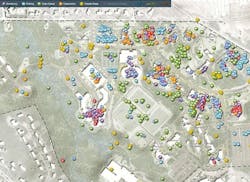Crowdsourced Placemaking: How people will help shape architecture
This article is part of BD+C's special five-part Technology Report 2014: Top tech tools and trends for AEC professionals.
Get ready, AEC professionals. The design table is about to get much more crowded—like really crowded. I’m talking hundreds, even thousands of voices, all providing invaluable input on your next project. These, of course, are the future occupants and end users of the spaces you create.
For the first time, the masses can have a real say in how the built environment around them is formed—that is, if Building Teams are willing to listen.
The rise of mobile devices and social media, coupled with the use of advanced survey tools and interactive mapping apps, has created a powerful conduit through which Building Teams can capture real-time data on the public—what spaces they like most and least in a given building, where they prefer to hang out on campus, whether they take public transportation or drive to work.
Using Twitter feeds, mobile apps, and security camera footage, Building Teams can observe how people move through a building or campus. They can pose hypothetical situations (“If we added a food court in the student union, how often would you use it?”) and ask for feedback on early design schemes.
With advanced traffic flow simulation programs that allow users to program thousands of avatars with unique behavioral characteristics, Building Teams can predict—with a much higher degree of certainty—how people will interact with a space layout.
Building-occupant research has long played a critical role in project planning. What’s changing is the immediacy and sheer amount of data, and the ease by which it can be collected and analyzed.
"Like it or not, the democratization of design is on the horizon. Terms like 'crowdsourced placemaking' and 'data-driven design' will soon become commonplace."
As the Big Data movement takes hold in the commercial construction market, your clients will be looking to you for more than just well-informed opinions and industry benchmarks on which to base their real estate decisions. Analytics will soon drive many planning and design strategies, and detailed occupancy evaluations—both pre- and post-occupancy evaluations (POE)—will play a larger role on projects.
AEC firms don’t exactly have a great track record when it comes to using POEs to learn from their past projects—an issue we raised last year (www.BDCnetwork.com/post-oc). In fact, many AEC professionals admit to rarely visiting their past work, even for informal observation. The coming data boom is going to force firms to incorporate this type of analytical research into their design and planning processes.
Arup, Perkins+Will, and Sasaki Associates are among the firms to develop custom digital tools for polling building occupants and end users. The firms also have extensive expertise in analytics and are applying advanced data-driven design techniques on projects.
“This type of analysis is leading us to conclusions that we would have never discovered otherwise,” says Raj Patel, a Principal with Arup. As an example, he points to the JetBlue Terminal 5 project at John F. Kennedy Airport in New York, where detailed traffic flow simulations and POEs showed that travelers would respond more favorably to small gathering areas rather than a single, large atrium approach that is common in airport terminals. This decentralized design strategy, the analysis showed, would also streamline pedestrian flow through the spaces, minimizing bottlenecks.
Like it or not, the democratization of design is on the horizon. Terms like “crowdsourced placemaking” and “data-driven design” will soon become commonplace. It’s up to Building Teams to hear these newfound voices at the design table.
About the Author

David Barista
David Barista is Editorial Director of Building Design+Construction and BDCnetwork.com, properties that combined reach more than 100,000 commercial building professionals, including architects, engineers, contractors, and building owners. David has covered the U.S. construction industry for more than a decade, previously serving as Editor-in-Chief of BD+C, Professional Builder, Custom Builder, and HousingZone.com. He has won numerous editorial awards, including six Jesse H. Neal Awards and multiple honors from the Construction Writers Association and the American Society of Business Publication Editors.
Email: [email protected]
